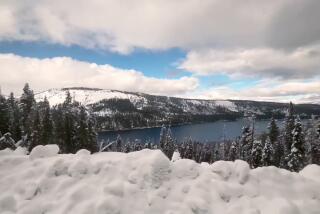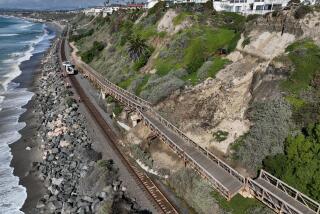Charles Dickens and the rail of two cities
“Here we are — no, I mean there we were… Flash! The distant shipping in the Thames is gone. Whirr!… Dustheaps, market gardens, and waste grounds. Rattle!...Shock!...Bur-r-r-r! The tunnel…I am… flying for Folkestone…Bang!… Everything is flying.”
-- “A Flight,” by Charles Dickens, describing a rail trip from London in the journal “Household Words,” 1851
::
Who knew that Charles Dickens, master scribe who brought us Scrooge, Copperfield and tale upon cautionary tale of hard 19th century life, was a transit aficionado with a story to tell traffic-snarled Angelenos about their plight?
I didn’t.
Then I met Jonathan Grossman, a UCLA English professor who has spent years studying Dickens’ views on the Victorian-era revolution in transportation, from horses to carriages to trains to steamships.
“Dickens was constantly analyzing the relationship between transportation and society,” said Grossman, author of the new book “Charles Dickens’s Networks, Public Transport and the Novel.”
“He tried to reflect back to the people of his day how the revolution they were experiencing was affecting their culture,” he said. “If he were alive now, looking at Southern California, it’s easy to imagine him doing the same.”
Intrigued, I invited Grossman for a light-rail ride. We ended up taking a trip from his thriving suburban hometown of South Pasadena to USC, which like UCLA is one of the region’s most important and vibrant institutions. We couldn’t have made this trip until last month. Train service has finally come to USC via the Expo Line, which is scheduled to link downtown to Santa Monica by 2016 — 204 years after Dickens’ birth.
“Dickens would have been surprised at how long it has taken Los Angeles to build its rail system,” the professor said as our Gold Line train eased into Chinatown. “He was so into the power of rail. Amazed by the sense of making you fly without effort. He’d say that creating a network can change the way a place views itself.”
::
In the 1830s, Dickens was an avid rider on what then was a popular form of mass transit — the stagecoaches that play a pivotal role in books like “The Pickwick Papers.” He watched trains replace stagecoaches and London’s subway system begin.
By 1870, the year Dickens died, London’s transit system was arguably better than the one serving Los Angeles today.
That’s right: 1870.
L.A. was just a dusty cow town then, but that’s no excuse. As the city boomed. we tore out our sprawling streetcar system to make more room for the almighty automobile. It wasn’t until the early 1990s that trains began carrying people again from one side of the city to another.
The rail network that’s being created — at a frustrating pace by multiple bureaucracies and warring politicians — has real merit. Parts are even fantastic. But taken together, it’s a disjointed mess with too many slow trains, too many transfers and not nearly enough service to prime locations.
Let’s put it this way: USC has train service now. Wonderful. That subway to UCLA? Don’t hold your breath.
It’s different in London and has been since Dickens’ day.
As Grossman tells it, Dickens heralded the way the working class now traveled with the upper crust. The man known as “The Inimitable” loved the controlled chaos, the way trips outside London that once took days suddenly took a few hours. “The world,” Dickens said to a friend, “was so much smaller than we thought. We were all so connected … without knowing it, people supposed to be far apart were so constantly elbowing each other.”
Grossman described how, for Londoners in the 1800s, “the transit network created a sense of togetherness, a sense that this is your place, your community.”
I didn’t get that feeling as I battled last week for a freeway lane change with a maniac, perched in his giant Escalade, tossing me a middle-finger salute as he nearly drove my Civic into a ditch.
But community is exactly what the professor and I felt as we transferred to our third train of the day. We were now on the last leg of our journey to USC, surrounded by school kids and secretaries, lawyers and unemployed accountants, old and young. Surrounded, basically, by L.A.
Grossman noted how we’d been on the rails for just over an hour. A drive under ideal conditions would take half that time. Not good. But then he looked out the train at a street jammed with cars and smiled.
Dickens would have embraced the automobile, the professor said. But he would also have found a way to skewer our belief that as we sit in our cars we’re masters of the universe, disconnected Scrooges cut off from the rest of the world, not responsible for anyone but ourselves.
::
The Inimitable would have plenty of other fodder in the land of the eternal traffic jam. You can imagine him cautioning about ill-designed train tracks dissecting neighborhoods. You can see him hammering L.A.’s bus service for being the nearly exclusive province of the poor. He’d burn a hole in the hides of politicians for paying little more than lip service to the simplest modes of getting around: biking and walking.
In “The Old Curiosity Shop,” Little Nell undertakes a fatal walk from London using treacherous paths that she is told were “never made for little feet like yours.” Reading that jolted me to think about the young woman who was recently hit by a car in my Silver Lake neighborhood. She died on Rowena Avenue, which has become yet another of our virtual freeways.
Dickens himself almost died in 1865, when a train he was riding on derailed, killing 10.. “No imagination can conceive the ruin of the carriages,” Dickens wrote, “or the extraordinary weights under which the people were lying, or the complications into which they were twisted up among iron and wood.”
Dickens wouldn’t shy from the perils of mass transportation. He’d give us a modern Little Nell and skewer transit apartheid and buses that have become roving billboards. Then he’d remind us that cars are far more dangerous, far less efficient, often far less fun.
“I can see him writing about this sense that we’re more than atomized beings, moving about in our cars, alone,” Grossman said. “We’re a community, there on the transit map, linked together. He’d believe as we build more of a network that can be seen as a whole, this togetherness is a concept people will begin to feel.”
People? Does that include maniacs in Escalades?
More to Read
Start your day right
Sign up for Essential California for news, features and recommendations from the L.A. Times and beyond in your inbox six days a week.
You may occasionally receive promotional content from the Los Angeles Times.







